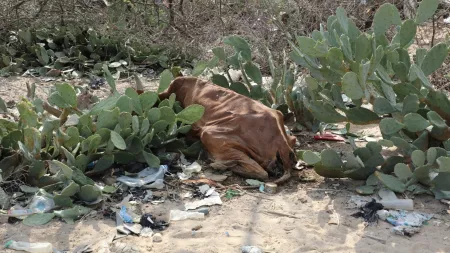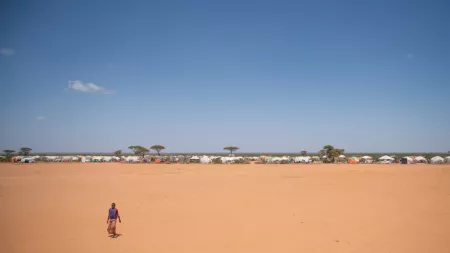Across Kenya, Ethiopia, and Somalia, the Horn of Africa is experiencing the extreme effects of climate change. Compounded by other factors, the impacts on communities have been catastrophic. CARE calls for the full funding of the Humanitarian Resource Plan in all countries to save lives.
The region is facing the worst food crisis in over 40 years, which has left over 31 million people in need of emergency assistance. Due to failed rainy seasons, two locust invasions, conflict, and rising prices of basic commodities in the wake of the Ukraine conflict, communities in the region have been decimated, leading to the migration of over 2.5 million people. Additionally, malnutrition has been on the rise for children in all three countries as families have lost their way of earning a living.
In the Horn of Africa, pastoralism used to be one of the key ways of earning a living for most communities. Due to extreme weather, over 13.2 million livestock have died. The impact of families losing their livelihoods has been particularly severe for women and girls.
In Kenya: Girls are forced “to pursue harmful coping mechanisms”
Leah Kaguara, CARE Kenya’s Country Director said: “Due to drought, women and girls are forced to move farther in search of water for their families. In Dadaab, women and children make up most recorded new arrivals each day at the camp. Education has also been impacted by the drought, especially in areas like Kajiado. Students, especially girls, had to drop out of school due to a lack of money to pay the fees and basic essentials like sanitary towels."
"At CARE, we are concerned that this will force girls to pursue harmful coping mechanisms that will be detrimental to their well-being and development. One of these could be child marriage, option families struggling with poverty have resorted to in such crises",warned Kaguara
According to the National Drought Management Authority, there are 4.4 million Kenyans across 23 arid and semi-arid counties who are in dire need of food assistance. The country needs at least $ 451.8 million to respond to the drought but only 21% ($94.7 million) of this response plan has been funded with the least funded sector being shelter.
In Somalia: Extreme weather drives displacement, disease, and hunger
Communities in Somalia have not only experienced five failed rainy seasons but are currently being affected by devastating flash floods. Ummy Dubow, CARE’s Deputy Country Director for Programs said: “Somalia is facing severe impacts of extreme weather patterns. Last year, over 43,000 people died as a result of drought. Since the end of April, several parts of the country suffered severe floods, causing widespread damage, loss of life, and displacement, as well as increased risk of disease outbreaks such as cholera. To that end, over 20 people have already lost their lives, 200,000 have been displaced from their homes, and more than 450,000 have been affected.”
In Somalia, women are responsible for 90% of food preparation and purchasing. As families struggle to cope, women are taking on more responsibilities. At the same time, women’s businesses have been adversely affected, forcing many to lose their sources of income. Due to a lack of resources, families have had to move from their homes in search of food and water. This in turn has resulted in families splitting up, exposing women and girls to a higher risk of gender-based violence as they transit from their homes. As of May, 1.4 million Somalis, 80% of whom are women and children, have been displaced by the drought.

In Ethiopia: Malnutrition Threatens Women and Children
In Ethiopia, 24 million people in drought-affected areas are facing a worsening food security situation leading to malnutrition and health conditions risks due to the climate crisis. Many communities have experienced below-average and late rainfall in the last five consecutive seasons. Inaccessibility of food and poor access to water has caused malnutrition amongst children, as well as women — particularly those who are pregnant.
Caitlin Goggin, CARE International’s Country Director in Ethiopia said: “This is the challenge of a generation; a humanitarian crisis unseen in Ethiopia for more than 40 years. As food insecurity becomes more acute in Ethiopia, we are particularly concerned about the impact on women and girls. Despite the fact that CARE has intervened early with food distributions for some affected communities, as well as cash transfers and health, nutrition, water, and hygiene interventions; the unmet needs remain staggering. Additional resources are needed to provide life-saving assistance to communities devastated by the ongoing drought and to help them rebuild more resilient and sustainable livelihoods.”
How to mitigate the crisis
CARE calls for three critical areas to be addressed to mitigate this crisis:
- Increase the volume and quality of funding for the Horn of Africa to address the intersecting impacts of climate change and food insecurity.
- Wealthy countries must deliver on their commitments from the Paris Agreement and prioritize climate financing, especially in fragile contexts and at the local level.
- The links between gender inequality and climate change are clear. There is an urgent need for more women’s leadership and greater financial support for a gender-transformative climate change response and gender-just solutions to climate-induced disasters, including displacement. Gender equality and the inclusion of women in all climate action — from adaptation to mitigation, and in humanitarian preparedness and response efforts — must be central.
For media inquiries, please contact David Mutua, CARE International East, Central, and Southern Africa Regional Communications Advisor via: [email protected]
Notes to Editors:
- CARE has spokespeople available for interviews from not only the specific countries but also the regional level.
- Across the three countries, CARE and its partners continue offering a humanitarian response in several sectors including water, sanitation, and hygiene; healthcare; food distribution; gender-sensitive hygiene kits; and psychosocial support.
- To fully address the needs of the Horn of Africa crisis, humanitarian partners will require $7 billion in 2023. Only $1.614 billion had been received as of 23rd May 2023, with funding shortfalls significantly hampering the response efforts. The Humanitarian response plans for each of the 3 countries %funded as of 23rd May 2023: Somalia, 25%, Ethiopia 21%, and Kenya 21%
